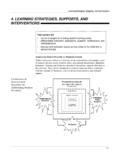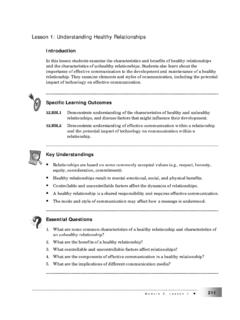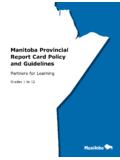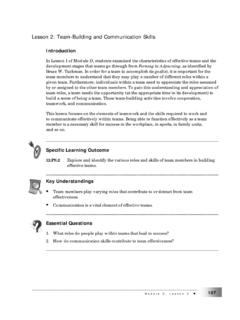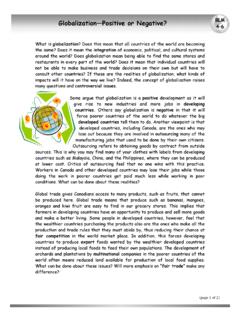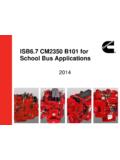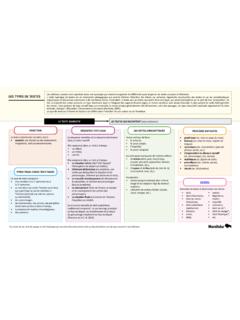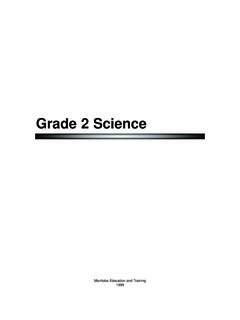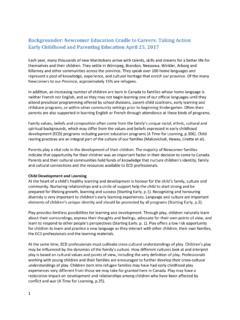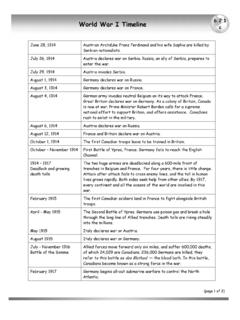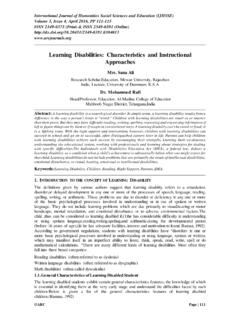Transcription of Grade 3 Assessment in Reading - Province of Manitoba
1 Grade3 AssessmentinReadingSupportDocumentforTea chersGRADE3 Assessment INREADINGS upport Document for Teachers2009 Manitoba Education, Citizenship and YouthManitoba Education, Citizenship and Youth Cataloguing in Publication Grade 3 assessment in Reading : support document for as a resource to support teachers inimplementing the Grades 3 and 4 Assessment policy, asidentified in Grade 3 assessment in Reading , Lecture, andNumeracy and Grade 4 Assessment in French ImmersionLecture ( Manitoba Education, Citizenship and Youth) bibliographical : 978-0-7711-4415-81. Reading (Primary) Manitoba Ability testing. I. Manitoba . Manitoba Education, Citizenship and Youth. II. Title : Grade three Assessment in Reading : supportdocument for teachers. III. Title : Grade 3 Assessment inreading, lecture and numeracy and Grade 4 Assessment inFrench immersion 2009, the Government of Manitoba , represented by the Minister ofEducation, Citizenship and Youth.
2 Manitoba Education, Citizenship and YouthSchool Programs DivisionWinnipeg, Manitoba , CanadaEvery effort has been made to acknowledge original sources and to comply withcopyright law. If cases are identified where this has not been done, please notifyManitoba Education, Citizenship and Youth. Errors or omissions will be correctedin a future edition. All images found in this document are copyright protected and should not beextracted, accessed, or reproduced for any purpose other than for their intendededucational use in this websites referenced in this document are subject to change. Educators areadvised to preview and evaluate websites and online resources beforerecommending them for student use. Ce document est disponible en fran resource is available on the Manitoba Education, Citizenship andYouth website at ContentsiiiCONTENTSI ntroduction1 Purpose1 Assessment Policy Overview1 Document Content and Organization2 Classroom-Based Assessment3 Formative Assessment3 Summative Assessment4 Grade 3 assessment in Reading5 Rationale for the Selection of Key Competencies in Reading5 Assessing the Key Competencies in Reading5 Competency 17 What Is This Competency?
3 7 Connections for Reading Competency 111 Competency 212 What Is This Competency?12 Connections for Reading Competency 218 Competency 319 What Is This Competency?19 Connections for Reading Competency 323 Reporting Assessment Results25 Overview of the Reporting Process25 Sending Results to Parents25 Sending Results to the Department25 Student performance below Competency Criteria25 Students with Exceptional Circumstances26 Grade 3 assessment in ReadingUsing Assessment Data27 Classroom27 School and School Division27 Province27 Appendices29 Appendix A: Planning with the End in Mind 29 Appendix B: Grade 3 Reading Assessment Criteria for Teacher Use30 Bibliography31ivIntroduction1_____* In this document, the term parentsrefers to both parents and guardians, and is used with the recognition that in somecases only one parent may be involved in a child s 3 assessment in Reading : Support Document for Teacherswas developed by ManitobaEducation, Citizenship and Youth as a resource to support teachers in implementing theGrades 3 and 4 Assessment policy, as identified in Grade 3 assessment in Reading ,Lecture, and Numeracy and Grade 4 Assessment in French Immersion Lecture (ManitobaEducation, Citizenship and Youth).
4 Grade 3 teachers may also use the information from this support document to defineand communicate to students and parents the knowledge, skills, strategies, and attitudesused by proficient readers to make meaning before, during, and after Reading Policy OverviewThe primary purpose of this policy is to improve student learning by identifying, earlyin the school year, students strengths and needs in key competencies in numeracy andreading and using this information to guide instructional planning. This formativeapplication of the policy is consistent with Assessment forand aslearning, as described inthe support document Rethinking Classroom Assessment with Purpose in Mind: AssessmentforLearning, Assessment as Learning, Assessment ofLearning ( Manitoba Education,Citizenship and Youth). Teachers must determine the performance level of students atthe end of October and report the information to parents.* By collecting the assessmentinformation early in the school year, and reporting it to parents, educators can use it toplan next steps in students learning and to support ongoing dialogue with parents toensure that students have the foundation knowledge and skills needed to supportlearning across the second purpose of this policy is to communicate summative information aboutstudent achievement in the key competencies.
5 This application of the policy reflectsassessment oflearning. There are three types of audiences for the achievementinformation. The first is the parent community, the second is the school-based learningteam consisting of teachers, administrators, and divisional leaders, and the third is thelarger educational and stakeholder communities, including the Department, the public,and researchers. These groups use the information to inform inquiry, look for trends,and make decisions about the provision of resources to support student Content and OrganizationGrade 3 assessment in Reading : Support Document for Teachersis organized into thefollowing sections: Introduction:The purpose and content of this support document are addressed herein relation to the purpose of the policy document Grade 3 assessment in Reading ,Lecture, and Numeracy and Grade 4 Assessment in French Immersion Lecture. Classroom-Based Assessment :This section addresses formative and summativeassessment practices.
6 Grade 3 assessment in Reading : Following an explanation of the rationale for theselection of the key competencies in Reading for the Grade 3 assessment in Reading ,this section discusses the three specific competencies being assessed: Competency 1: Student reflects on and sets Reading goals. Competency 2: Student uses strategies during Reading to make sense of texts. Competency 3: Student demonstrates each competency, teachers are provided with a description of the readingcompetency to be assessed, along with strategies for assessing the particularcompetency. This is followed by a Connections chart which outlines the links amongthe following: Grade 2 English language arts learning outcomes from which the competencywas developed (from Kindergarten to Grade 4 English Language Arts: ManitobaCurriculum Framework of Outcomes and Grade 3 Standards) the Reading competency, with three levels of performance ( Grade 3 entry) used todetermine student achievement of the learning outcomes the related descriptors from Developmental Reading Continuum (Phase 1) Reporting Results:This section discusses the three audiences to whom assessmentdata is reported at the beginning of the school year to encourage collaborative effortsby parents, the Department, and the teacher team in the school to improve studentlearning.
7 Using Assessment Data:This section explains how the information gleaned from theassessment is used in the classroom, in the school and school division, and by theDepartment. Appendices: Additional tools are provided to help teachers implement theprovincial Grade 3 assessment in Reading . Appendix A: Planning with the End in Mind A sample planning sheet has been included that may be used by individualteachers or Grade -level teams to plan Assessment strategies for the Grade 3 assessment in 3 assessment in Reading2 Appendix B: Grade 3 Reading Assessment Criteria for Teacher UseThis chart outlines specific criteria (components and characteristics of successfulperformance) for each of the Reading competencies being assessed. This chartmay be used when communicating to students and parents the knowledge,skills, strategies, and attitudes used by proficient readers. Bibliography:The bibliography provides an overview of all of the sources consultedand cited in the development of this AssessmentFormative Assessment moves learning forward.
8 It embodies two aspects: Assessment forlearning, done primarily by the teacher, and Assessment aslearning, which is done bythe student. The teacher gathers and reflects on information in order to adjustinstructional pacing, content, and strategies. Students also use Assessment informationto make adjustments in learning strategies and has found that the following strategies are the most powerful when teachersuse them to inform instruction: clarifying and sharing learning intentions and criteria for success engineering effective classroom discussions, questions, and learning tasks providing feedback that moves learning forward activating students as the owners of their own learning activating students as instructional resources for one another (Leahy et al. 18)The active engagement of students is an essential element of formative Assessment thatmakes a positive difference in student learning. To become independent learners,students need to get an idea from the start of what is to be learned.
9 Therefore, theteacher needs to explain the learning outcomes targeted, and have the studentsparticipate in setting criteria identifying performance indicators obtaining feedback from others (peers and teacher) further clarifying the criteriaTeachers model Assessment of a performance or product against the established criteriafor quality work. Students then practise comparing their work to these establishedcriteria by providing themselves and others with feedback as they reflect on their ownwork and the work of their peers. Classroom-Based Assessment3 Teachers further support students by helping them to revise their work and move itcloser to the established criteria. Students accomplish this by using their own personalfeedback, as well as feedback from their peers and teachers. Ultimately, through thismodelling of practice, and using feedback to adjust understanding and performance ,students can learn not only to self-assess but also to understand the criteria better self-regulate their learning determine their next stepsThese are critical steps in becoming independent, lifelong AssessmentThe intention behind summative Assessment , also referred to as Assessment oflearning,is to produce defensible and accurate descriptions of student knowledge and skill inrelation to defined outcomes and to present this information in summative reports foruse at the individual student or aggregated levels.
10 It requires the collection ofinformation from observations, conversations, work samples as well as theinterpretation of this information about students accomplishments in the keycompetencies in relation to established criteria that represent the nature and complexityof the intended methods and multiple opportunities help ensure reliable results that can beinterpreted and used both within and outside the classroom context. Assessmentmethods need to be congruent with learning goals. Grade 3 assessment in Reading4 GRADE3 Assessment INREADINGR ationale for the Selection of Key Competencies in ReadingThe concept that all learning is mediated by language is a foundational premise ofeducation. In classrooms, Reading plays a major part in all subject areas. Being able toread and understand others ideas are essential skills for success in school and three specific competencies for the Grade 3 assessment in Reading are Competency 1: Student reflects on and sets Reading goals.
